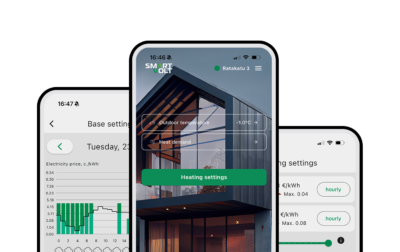How to Migrate to React Native from PWA: 2025 Ultimate Guide
Intro
Your PWA (progressive web app) got you to market fast: easy setup, no need for separate iOS and Android versions, and a quick way to test your ideas. That was great for getting started — but what worked early on is likely no longer meeting growing user expectations.
Users expect speed, polish, and app store access — things a PWA can’t deliver.
React Native, on the other hand, is built for native performance and seamless access to device features. It’s trusted by tech giants, startups, and likely your competitors.
Sure, React Native migration from a PWA can feel risky. But with the right approach, it doesn’t have to be. In this guide, Touchlane will walk you through migrating from PWA to React Native with less stress and more confidence — so you can deliver an app your users will love.
KEY REASONS TO MIGRATE TO REACT NATIVE FROM PWA
1.
PERFORMANCE
PWAs can feel slow on mobile because they’re essentially web apps in a browser. When you tap to open the app, it first loads in the browser. This causes long load times, choppy animations, and bad responsiveness, especially on cheaper phones. Users don’t like that “web feel” and leave fast.
For more, check out our blog on PWA performance where Touchlane’s Lead Mobile Developer Oleg explains when a PWA can still be the better choice over native apps.
React Native apps are faster and smoother because they use real native components. When you open the app, it launches quickly and feels responsive — taps, swipes, and scrolls are immediate. The result is better load times, higher engagement, and lower bounce rates — exactly what your competitors are already seeing.
To see if React Native fits your case, visit our blog post about React Native development — it breaks down the pros and cons to help you decide.
2.
NATIVE USER EXPERIENCE
Since PWAs are websites that act like apps, even when “installed” on your phone, they can feel slow. For example, if you try to use the camera to scan a QR code, it might not work as fast as you’d like. And if you lose your internet connection, the app could stop working entirely because it relies on being online.
React Native, on the other hand, works like a regular app and runs directly on your phone. This means it’s faster, more responsive, and can easily access features like the camera and NFC without any slowdowns. Your users will get the seamless experience they expect.
3.
APP STORE VISIBILITY
PWAs don’t show up in the App Store or Google Play — so you miss out on millions of users searching for apps there.
With React Native, you can publish to both stores and tap into massive built-in distribution. But it’s not just about downloads. App store presence builds credibility, signals product maturity, and unlocks new acquisition channels — all things investors and users expect from a serious mobile product.
4.
TEAM AND TALENT
Hiring for PWA tech is getting harder — interest is fading, and fewer developers want to work with it long-term.
React Native, on the other hand, has a growing, active talent pool. Even better, your current React web devs can often ramp up quickly, since the learning curve is low. That means less time hiring, faster onboarding, and more room to scale without overhauling your team.
5.
INVESTOR EXPECTATIONS
VCs and stakeholders most care about growth metrics: retention, engagement, conversion. And all of those are deeply tied to mobile UX.
If your PWA feels clunky compared to a competitor’s native app, users will bounce — even if your features are solid. React Native helps you close that UX gap and stay competitive.

Thinking about a React Native migration? Discover how to migrate from PWA to React Native with a clear step-by-step guide, plus insights on performance, UX, and app store visibility.
IS IT THE RIGHT TIME TO MIGRATE TO REACT NATIVE FROM PWA?
Probably, you’re not a megacorp with infinite devs. You’re a small team with big stakes. So how do you know if this migration is actually worth it?
Here’s a simple way to break it down:
REVIEW YOUR PRODUCT REQUIREMENTS
React Native is great for apps that need tight integration with mobile hardware — like using the camera, sending push notifications, or working offline. But if your app doesn’t depend on those features, a PWA can be the simpler and more budget-friendly choice.
For example, migrating to React Native might not be necessary when:
- Your app is a simple platform for browsing, like a blog or a news site. Users mainly scroll and read, and a PWA can handle that easily.
- Your PWA is an internal tool for employees, like a time tracking system, used mainly on desktops in offices with stable internet. A web-based app that works across all browsers would be enough.
- Your app is an MVP or an early-stage product. If you’re still validating your idea, a PWA helps you get feedback quickly without the extra effort of app store distribution or native development.
In short, if your users aren’t demanding mobile-native performance or features, a PWA can still do the job — no point in jumping into a migration you don’t really need.
ASSESS YOUR TEAM’S CAPABILITIES
Migration is a serious project — and it takes solid technical skills. If you plan to handle it in-house, make sure your team is ready.
Here are some skills to look for:
- React or JavaScript experience, because React Native builds on both.
- Familiarity with the React Native ecosystem, including tools like Expo, React Navigation, or Redux.
- Mobile development know-how, like working with navigation, gestures, and native modules.
- Understanding of the mobile release cycle, including device testing, store submission, update processes, etc.
And so on.
If your team’s missing some of this, it’s still doable — as long as they’re open to learning and you can invest in training. Otherwise, bringing in short-term support can fill the gap and keep the migration on track.
CONSIDER TIMING AND CONSTRAINTS
Timing matters. A migration is easier when things are stable — ideally not right before a big launch or fundraising push.
You don’t need to do everything at once. Many teams start by moving over core flows, test on a smaller audience, and scale from there.
BONUS: A QUICK MIGRATION READINESS CHECKLIST
At Touchlane, we’ve put together a short checklist to help you decide if migrating from a PWA to React Native is the right move.
Give it a try. It’s quick, practical, and built for teams like yours.
- We need better mobile performance and UX.
- We want to use native features (camera, push notifications, etc.).
- We want to improve how users engage with our mobile app.
- We need to be on app marketplaces to reach more users.
- We have a stable timeline, with no big releases or pressure.
- Our team knows React, can quickly learn React Native, or we’re ready to bring in experts to fill the gaps.
If you checked most of these, the case for migration is strong.
Need mobile developers?
STEP-BY-STEP GUIDELINE ON HOW TO MIGRATE TO REACT NATIVE
Here’s how a React Native migration process typically looks like in detail.
1.
STEP 1. GET CLEAR ON THE BUSINESS REASON BEHIND THE MIGRATION
Start with the real reasons driving the migration. Is your PWA underperforming with slow load times or poor UX? Are you struggling to reach a wider audience? Or is engagement and retention low because your app feels outdated compared to native apps? Sometimes, it could be all of these.
Knowing your goals helps define what success looks like. That way, you’ll know if the migration actually worked. For example:
- If you’re aiming to boost retention, you might want to measure session duration or uninstall rates.
- If performance is the pain, define a target load time (e.g., <1.5s on a mid-range Android).
- If discoverability is the driver, check the current mobile web funnel: how many users land on your PWA from mobile, how many drop off before sign-up or conversion, and how often people return.
Get your tech team, product leads, and business stakeholders aligned. Migration is a big task, so having a clear goal and understanding of success will keep everyone on track and make decisions easier.
2.
STEP 2. AUDIT YOUR CURRENT PWA
Look at your current PWA and decide what you can keep and what needs to be changed. The backend, like your APIs and business logic, can usually stay the same, which saves you time. But things like the app’s design and elements that depend on the browser (offline access, data storage, etc.) won’t work well on mobile and will need to be reworked.
For example, a PWA stores data in your web browser so it can work offline. That works fine for small websites, but on mobile, it’s not reliable because mobile browsers aren’t built to handle large amounts of data. That’s why native mobile apps use other storage solutions.
Understanding what needs to change — and what can be reused — will help you plan the work ahead and allocate resources efficiently.
3.
STEP 3. DECIDE WHAT TO SHIP FIRST
You don’t have to rebuild everything at once. Start by prioritizing the most used or most critical features for the mobile app. Of course, these depend on your app and its core functionality, but typically they include user login, order management, and payment processing. Less critical components, such as social media integrations, can be delayed to keep things on track. Again, this should be decided based on what’s truly critical for your specific project.
4.
STEP 4. REBUILD THE USER INTERFACE FOR MOBILE
In most migration projects from PWA to React Native, the UI is rebuilt. Mobile screens are smaller, and users interact with touch gestures instead of mouse and keyboard. What works on desktop — like large tables or sidebar navigation — won’t translate well to a mobile screen. That’s why Android apps follow Material Design, and iOS apps follow Apple’s Human Interface Guidelines — and you should too.
You’ll need to rebuild the UI using React Native components, which are optimized for touch gestures and smaller screens. Think large buttons for easy tapping, a simplified layout, and vertical scrolling. At this step, the goal is to make sure your app feels like a native mobile experience and performs well.
5.
STEP 5. ADD MOBILE-ONLY FEATURES
Now’s the time to bring in features PWAs can’t handle well — camera, file uploads, push notifications, etc. React Native supports most of these out of the box, and others can be added with plugins or light native code.
For example, React Native has built-in camera support for taking pictures or scanning QR codes. And to select photos from the device library or camera, you can use a ready-to-use plugin, no custom code needed.
6.
STEP 6. SET UP BUILD AND RELEASE TOOLS
When you’re migrating to React Native, setting up the right build and release tools is critical. These tools make sure your app is tested, compiled, and ready to go without any problems.
For example:
- Xcode (for iOS) and Android Studio (for Android) test, compile, and deploy your app to ensure it’s ready for distribution on the App Store and Google Play.
- Jest tests individual functions to guarantee that each part of the code performs as expected.
- Detox is used for full-system testing. It simulates user interactions to check that the entire app works correctly before launch.
- Setting up a CI/CD pipeline with tools like Bitrise or CircleCI speeds up development, reduces errors, and delivers faster, more reliable updates. This helps you respond quickly to user feedback, improve app quality, and stay competitive.
With an efficient process and reliable tools in place, you’ll release the app and push out updates faster, fix issues immediately, and keep improving the app over time without unnecessary delays.
7.
STEP 7. ROLL IT OUT GRADUALLY
A big public rollout can easily turn into a big mess: the app might crash frequently, users may experience slow load times or lag, features could malfunction, and you’ll end up spending days fixing bugs, addressing complaints, and managing frustrated customers.
A phased rollout helps avoid these problems. Here, you start with internal testing, then move to a small group of users. This lets you track how the app performs in real conditions, catch bugs, and address user experience issues early before a wider release. You can also gather valuable feedback on new features, make adjustments, and ensure the app scales smoothly as more users join. Plus, it prevents overwhelming your support team with issues all at once.
8.
STEP 8. MONITOR AND OPTIMIZE AFTER LAUNCH
Post-launch, the focus shifts to refining performance and user experience.
- Closely monitor your app’s performance by reviewing real-time crash reports, error logs, load times, and other performance metrics. Make sure to regularly check them, especially right after updates or new features are rolled out.
- Track user behavior to see how users are engaging with your app. Pay attention to things like how often they use it, where they drop off, and which features they engage with most. Google Analytics or more granular Mixpanel and Firebase Analytics can help with that.
- Focus on the KPIs you set as success criteria at the start of your migration — things like user acquisition, session duration, and in-app purchases. Are you seeing growth in the number of users after the migration? Are they spending more time in the app or using more features per session? Are you hitting your revenue goals through purchases or subscriptions? These metrics will give you a clear picture of how the migration is performing and whether it’s driving the results you wanted to achieve.
The goal is simple: keep improving the app based on real data. Address issues quickly, tweak features that aren’t performing, and continuously optimize for the best possible user experience.
And remember, you don’t have to do everything on your own. Talk to someone who’s done it dozens of times. For example, Touchlane can help you figure out if React Native is the right move — and what it would take.

REACT NATIVE MIGRATION: COMMON CHALLENGES AND WAYS TO OVERCOME THEM
PERFORMANCE ISSUES WITH REUSED CODE
Problem: It’s tempting to reuse as much of your PWA code as possible when moving to React Native. But not everything will work the same on mobile. The issue often comes from complex web-specific components and code (think large images, custom video players, complex JavaScript, and so on), which can slow the app down and mess with performance.
Solution: As we mentioned earlier, a good strategy is to reuse backend logic and business rules (APIs, data processing, etc.), because these can stay consistent across platforms. But the app UI and mobile-specific interactions should be rebuilt using React Native components. This way, your app will work well on mobile and feel native to users.
INCONSISTENCIES BETWEEN ANDROID AND IOS
Problem: While PWAs are platform-agnostic and run in browsers, React Native app often need platform-specific tweaks. This can lead to inconsistencies. For example, animations may be smooth on Android but lag on iOS, or push notifications might work on one platform but fail on the other.
Solution: React Native needs testing on both Android and iOS. Basic mobile testing (functionality, usability, and performance) still applies, but you’ll need to adjust for platform differences. Animations, scrolling, and responsiveness may need tweaks for consistent performance on both devices.
APP STORE APPROVAL
Problem: Unlike a PWA that goes live instantly, app stores have strict rules, review times, and can reject your app for things you didn’t expect — like unclear permissions, missing privacy policies, or poor onboarding UX.
Solution: To avoid delays, study Apple’s and Google’s guidelines early — especially around permissions, data use, and privacy policies. Prepare everything you’ll need ahead of time — icons, screenshots, descriptions, and policy links. Use TestFlight and Google’s testing tracks to catch issues early. And expect at least one rejection — it’s normal. What matters is how fast you respond and resubmit. With the right preparation, you’ll speed up approval and avoid frustrating back-and-forth with store reviewers.
For a detailed breakdown of publishing on Google Play, check out this guide on how to publish your app in 2024.
Conclusion
PWAs allow for quick launches, but they lack speed, polish, and app store availability. Migrating to React Native makes sense in many cases, as it offers faster performance, better design, access to device features, and the ability to publish in the App Store and Google Play.
But React Native migration may feel scary: there’s the risk of losing users, the complexity of rebuilding the UI for mobile, and concerns about timely updates. To avoid this, it’s advised to prepare and stick to the plan. Key steps include auditing the PWA, rebuilding the UI for mobile, adding mobile features like push notifications and camera access, setting up build tools, and rolling out in phases with post-launch optimization.
Migration requires solid tech and project management skills, as well as expertise in React/JavaScript and mobile development. If you’re unsure that your internal resources are sufficient to handle this migration, consider bringing in support or partnering with experts for a smoother transition.
RELATED SERVICES
CUSTOM MOBILE APP DEVELOPMENT
If you have an idea for a product along with put-together business requirements, and you want your time-to-market to be as short as possible without cutting any corners on quality, Touchlane can become your all-in-one technology partner, putting together a cross-functional team and carrying a project all the way to its successful launch into the digital reality.
If you have an idea for a product along with put-together business requirements, and you want your time-to-market to be as short as possible without cutting any corners on quality, Touchlane can become your all-in-one technology partner, putting together a cross-functional team and carrying a project all the way to its successful launch into the digital reality.
We Cover
- Design
- Development
- Testing
- Maintenance











